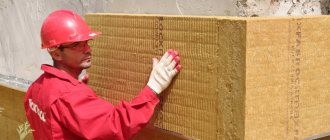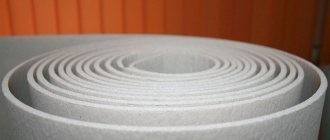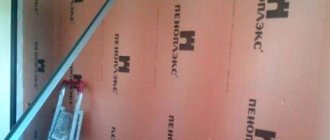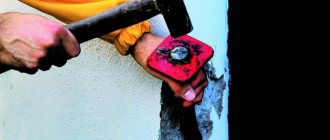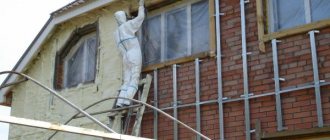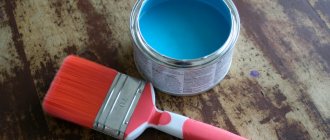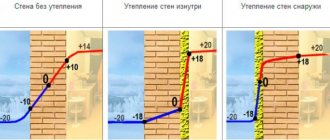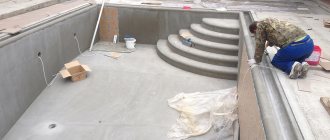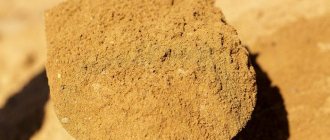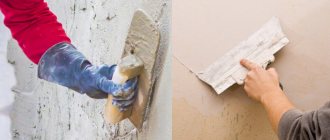Mineral wool for plaster: advantages and features of types for facade insulation
Mineral wool is a universal insulating material that can effectively insulate a facade and reduce the cost of heating a room. It goes well with plaster and can be used for any type of building.
Features and benefits
Mineral wool is a fibrous slab with dimensions of 60x120 and 50x100 cm. The thickness of the products is 5, 10 and 15 cm. Ten-centimeter slabs are the most in demand. This thickness is sufficient for using the material in harsh climatic conditions, under the influence of negative temperatures and large amounts of precipitation.
The fiber density of facade slabs is slightly higher than that of the material intended for interior decoration and corresponds to 130 kg/m3. The high density and elasticity of mineral wool are necessary conditions for its installation under plaster. The slabs must withstand the weight of the applied solution and retain their original qualities when it dries.
Due to the fact that most of the country is located in a cold climate zone, mineral wool is in high demand in the domestic building materials market.
The popularity of the material is due to a number of undeniable advantages:
- The excellent heat and sound insulation properties of wool guarantee heat retention at temperatures below 30 degrees, and reliably protect the home from street noise;
- High fire resistance and non-flammability of the material guarantee complete fire safety of the slabs, which begin to melt only at a temperature of 1000 degrees;
- Rodents, insects and other pests do not show interest in mineral wool, so their appearance in it is excluded;
- Excellent vapor permeability promotes moisture removal and rapid elimination of condensation;
- Resistance to moderate mechanical stress significantly increases the service life of the facade, and makes the use of cotton wool preferable to the use of polystyrene foam;
- The absence of the need for additional thermal insulation of interpanel seams solves the problem of heat loss in large-panel buildings;
- The low cost and availability of the material make it possible to finish large areas at minimal cost.
The disadvantages of mineral wool include the presence of formaldehydes in its composition, which have a negative impact on the health and well-being of others. When purchasing, you need to make sure that you have a certificate of conformity and markings from the regulatory authority. This will help avoid purchasing low-quality products and will guarantee the safety of raw materials.
Mineral wool installation work must be carried out using personal protective equipment. The disadvantages include the need to treat the slabs with a hydrophobic compound. If this is not done, the cotton wool will absorb moisture and lose its thermal insulation qualities.
Mineral wool is produced in three modifications, which differ in composition, purpose and performance characteristics.
- Glass wool. Made from sand, soda, borax, dolomite and limestone. The fiber density corresponds to 130 kg per cubic meter. The material is able to withstand heavy loads, has a thermal resistance limit of 450 degrees and thermal conductivity of up to 0.05 W/m3.
The disadvantages include the volatility of fine-fiber components, which requires the use of a respirator and gloves during installation. The wool can be equipped with foil or fiberglass, which somewhat reduces fiber dispersion and increases wind protection.
- Stone (basalt) wool. It is made from volcanic lava rocks and has a porous structure. The heat-saving and sound-proofing characteristics of stone wool are superior to those of other types, making the material a leader in consumer demand in its segment. The advantages of this type include heat resistance up to 1000 degrees, high resistance to mechanical stress and the presence of hydrophobic substances in the composition, which makes it possible to do without additional treatment of the slabs with water-repellent compounds. The disadvantages include the presence of formaldehyde and the inability to use cotton wool for interior decoration.
- Slag wool. Metallurgical slag waste is used in the production of boards. The texture of the fibers is loose and has good thermal insulation properties. The advantages include low cost and increased heat-saving properties.
The disadvantages include the high absorbency of fibers, which is why slag wool requires mandatory moisture-repellent treatment and cannot be used for insulating wooden buildings. Low vibration resistance and increased acid residue are noted.
For the installation of mineral wool under plaster, it is recommended to use special facade types: universal slabs Ursa Geo and Isover and rigid slabs Isover - “Plaster facade” and TS-032 Aquastatik. When choosing cotton wool for outdoor use, it is necessary to take into account the grade of the material. For “wet facades” it is recommended to purchase brands P-125, PZh-175 and PZh-200. The last two types have powerful performance indicators and can be used for cladding any types of buildings, including metal and reinforced concrete surfaces.
Price issue
In conclusion, let’s say, the insulation for a facade under plaster can be either ordinary polystyrene foam, extruded polystyrene, or mineral wool. There are no better or worse materials, each insulation suits you relatively. Knowing the properties of each material, it is necessary to think about how to compensate for the shortcomings. If it is important for you to live in a house with natural ventilation and a good indoor microclimate, then it is better to use vapor-permeable mineral wool than polystyrene foam. If you want to save money, but are willing to lose quality, use polystyrene foam, but consider forced ventilation in the house.
Extruded polystyrene foam is denser and lasts longer, but regular foam is cheaper and may be easier for you to replace when it wears out.
Mineral wool is vapor-permeable and does not burn, but it costs three times more and can absorb water if installed incorrectly. If stone wool gets wet, it will lose all its energy-saving features.
- Ordinary polystyrene foam PSB-S 25 costs 1500 rubles/m3;
- Extruded polystyrene foam costs 2800/m3;
- High-density mineral wool (at least 120 kg/m3) costs 4800/m3.
Each insulation material is certified for use and can be used in plaster facade systems. Now you know the properties of each, choose according to the set of characteristics you need.
Similar articles
- Insulation of facades with mineral wool under plaster...
Insulation of facades with mineral wool
under plaster
involves the creation of a multi-layer “fur coat”, which includes
... Insulation under
siding. Read more - Insulation of external walls with mineral wool or penoplex under…
Similar publications.
Insulation
for exterior walls of a house
under plaster
. DIY siding installation: instructions for dummies. Read more - Universal technology for plastering facades using…
To ensure that
plaster
over
the insulation
has a beautiful appearance, the following ball of plaster mixture is applied. The task is... Read more - Which is better: siding or plaster?
Both siding and
plaster
for
insulation . As you can see, it is difficult to find an exact answer to the question of which is better - a wet facade or siding. Read more - Features of using façade plaster…
This porous lightweight material is used as
insulation under plaster
for walls both inside and outside the house. Read more - How to correctly: whether or not to install a vapor barrier...
Wet
insulation
loses up to 90% of the energy saving characteristics declared by the manufacturer. Read more
Installation technology
Before you begin cladding the facade, you need to prepare the wall surface. To do this, it is necessary to clean it from oil contaminants and dismantle the metal elements. If it is not possible to remove them, then they should be provided with a constant flow of air, which will prevent their premature corrosion and destruction. In such a situation, you should refrain from using acrylic plaster due to its poor ventilation. Old plaster and remaining paint must also be removed.
The next step should be hanging the wall. To do this, you need to drive in reinforcing pins and stretch nylon cords between them. The use of sags will help to evaluate the geometry of the surface and correctly calculate the required amount of material. Next, you can begin installing the guide profile. You need to start with the installation of the base element, which will serve as a supporting guide for the first row of slabs and will allow you to control the distance between the bottom row and the wall surface.
After installing the guide profile, you should begin cladding the facade with mineral wool. When fixing the slabs, you can use driven dowels or special glue. Then the mineral wool is reinforced with a metal mesh, the lower edge of which should be folded under the profile. The mesh must be secured with adhesive-reinforcing plaster.
The final stage will be covering the mineral wool with decorative plaster. For finishing work, you can use silicate, mineral, acrylic and silicone plaster mixtures. It is recommended to paint the plastered surface.
Mineral wool allows you to quickly and effectively solve the problem of facade cladding, significantly reduce heat loss and significantly save your budget. And the ease of installation and accessibility ensure the material’s growing popularity and high consumer demand.
See video instructions for installing mineral wool below.
Areas of application of warm plaster
Insulated plaster is used not only to decorate the façade of a building, it can also be used:
- for the purpose of sealing cracks;
- for insulation of building walls;
- when sealing floor joints, as well as for insulating floors and ceilings;
- for the purpose of insulating the basement of the building;
- when designing window slopes and doorways;
- for insulation of sewer risers for cold and hot water supply.
In addition, this mixture is used not only for exterior decoration, but also for interior work.
Peculiarities
Mineral wool is a very popular heat-insulating material that is laid under plaster. Its structure is made up of randomly intertwined fibers. The length and thickness of the fibers depend on the substance underlying the production of the material. To increase the strength of mineral wool, the fibers are compacted, but between them there remains a space filled with air, which performs a thermal insulation function. Despite the compaction procedure, mineral wool is a light, elastic material, convenient for transportation, installation and has a low price.
Mineral wool has a wide range of advantages over other materials:
- it is a good heat and sound insulator;
- maintains a high level of fire safety;
- permeable to steam, which is necessary for the house to “breathe”;
- fungi and mold do not form on it;
- insects do not grow in it, it is “uninteresting” to rodents;
- is a relatively environmentally friendly and safe material (the release of harmful substances begins at temperatures above 300 degrees C).
Like any material, mineral wool has certain disadvantages:
- First of all, this is the formation of a high level of dust . Glass wool and slag wool are especially guilty of this. Their dust contains sharp small fragments, which, if they come into contact with the skin, will cause damage and severe itching. Breathing dust containing debris is also extremely harmful. To avoid such unpleasant consequences, installation work should be carried out using special clothing, a respirator and safety glasses.
- Another disadvantage is the use of formaldehyde resins in the production of the product, and there is a possibility of phenol being released into the environment, which is unsafe for human health. However, there are very few of these substances in the product, and its use for outdoor work completely reduces this harm to zero. In addition, phenol is released at very high temperatures, which are unlikely to occur in everyday real life. Stone mineral wool practically does not contain phenol. Modern manufacturers, caring about the quality of the product, replace formaldehyde resins with other substances with a lower level of harmfulness. Nevertheless, carrying out work in a respirator and using vapor-proof PVC film during installation will protect against the possible risk of damage from phenol.
- A serious disadvantage may be the ability of the material to absorb moisture (stone wool does not have this disadvantage). Trapped moisture can cause shrinkage of the insulation and its destruction. Therefore, all external work should be carried out in warm, dry weather. In order for the coating to serve for a long time, you need to follow the installation rules, and also remember to use a hydrophobic solution to treat the coating.
For mineral wool, an important indicator is density, which is determined by the production method. For different jobs, insulation materials of different densities are used:
- The lightest (up to 80 kg/m3) is needed for indoor work.
- For external work, a special façade series is needed for plastering. Its density is 125-165 kg/m3. Such a high density is required for the strength of the coating and to support the weight of the plaster.
This type of insulation is produced in slabs of 50x100 or 60x120 cm. The average thickness of the slabs is approximately 10 cm. Sometimes high-density material can be found in rolls.
You can insulate any surface with mineral wool: brick, concrete, wood, block. However, different surfaces require their own types of insulation and methods of attaching it, and some of their indicators may differ greatly. Therefore, before purchasing, carefully read the characteristics of the insulation and its compatibility with a particular type of surface, take into account all the pros and cons.
Do-it-yourself technology for applying warm plaster
For facing work on the facade, you should choose warm, low-wind, dry weather.
The solution should be mixed immediately before application: in the proportion specified by the manufacturer, dissolve the dry mixture in a large container and mix for several minutes. Then wait about ten minutes and mix the composition again to obtain its homogeneity.
IMPORTANT!
The prepared mixture retains its properties for up to four hours.
It is recommended to apply the composition intensively to avoid hardening.
Warm mixture
The solution is applied as follows:
- beacons should be installed at a distance of 50 cm to obtain an even layer;
- It is advisable to first apply the solution with a small spatula, then with a large one. The mixture is applied from bottom to top. After covering a meter to one and a half walls, the applied mortar should be leveled according to the rule;
- the surplus removed by the rule can be reused;
- After applying the coating, the beacons should be removed , the holes from them should be sealed with a solution and the surface should be leveled.
CAREFULLY!
When the layer thickness exceeds 4 cm, it is necessary to lay a reinforcing mesh.
Despite the plasticity of warm plaster, a thick layer can crack. The recommended layer thickness is two centimeters: this way the mixture will not slide down. Each layer is applied on the completely dried previous one, so it will take a sufficient amount of time to complete the coating in several layers.
Reinforcement
If, nevertheless, the thickness of the first layer is 4 cm or more, it is necessary to continue the work sequentially:
- The first layer is covered with a reinforcing mesh two hours after its application;
- Apply the mixture in a thin layer to the reinforced mesh and profile with a notched trowel;
- after 24-48 hours, apply a second layer of solution in the same way as the first.
IMPORTANT!
As practice shows, a layer of 5 centimeters is enough for the result to meet the requirements . This layer has thermal insulation and other properties inherent to this type of coating.
If the need arises, after the facing coating has completely dried, it is decorated with additional materials (decorative plaster, paint). You can decorate the surface with artificial stone, ceramic tiles, granite chips and other decorative facing materials.
Before using them, the dried surface of warm plaster should be coated with a primer solution.
Alignment
Thus, warm plaster is not only an external coating that protects the facade, but also an additional heat-insulating material that can reliably insulate the walls of a building. At the same time, it is possible to reduce the cost of the main insulation layer, as well as decorate the walls with an additional decorative coating.
Carrying out work on applying warm plaster will not be difficult. In addition, this type of coating fits well with any walls and does not require additional leveling.
What is the density of façade insulation?
One of the ways to save money in the face of constantly rising energy tariffs is to carry out high-quality finishing and insulation of the facade of the house. In addition to reducing the cost of paying heating bills, the use of various materials to insulate a house from the facade does not reduce the usable area of the room. The choice of the type of facade thermal insulation largely depends on the chosen method of finishing it. In the case of using a mixture for leveling, facade insulation in the form of expanded polystyrene or mineral wool, the density of which has a significant impact on the thermal insulation properties, can potentially be used.
Briefly about the main thing
To insulate the facade, it is better to use slab-type thermal insulation with high strength and hardness.
The best options are polystyrene foam, polystyrene foam and mineral wool (stone, basalt).
Installation of thermal insulation is carried out using an adhesive solution and plastic dowels with wide caps. The metal core must have a plastic or polymer tip.
A reinforcing mesh is attached on top of the insulation; the corners are formed using a perforated profile. Finally, base or decorative plaster is applied.
Ratings 0
Characteristics of mineral wool: density and thickness
The selection of rigid mineral wool with certain density indicators is carried out taking into account the characteristics of the object on which finishing work will be carried out. This condition is of particular importance, given that insulating a façade using a low-density material can lead to:
- reducing the thickness of mineral wool;
- the formation of unclosed areas and cracks;
- compaction of mineral wool used in façade finishing;
- changes in the dimensions of the material declared by the manufacturer.
Any type of wool is a product obtained as a result of special processing of stone, glass or slag. It is recommended to carry out insulation with each of the following types of material in accordance with the recommendations of specialists for finishing the facade, external or internal enclosing structures. According to the classification, there are 3 types of mineral wool heat-insulating substances:
- Basalt wool, which does not ignite but melts when interacting with fire, is characterized by low water absorption rates. Insulation of this type is used in conjunction with processing for decorative thin or thick-layer plaster, sound insulation and insulation of roofs, walls, ceilings, ventilated facades and the “wet facade” system. Its density varies depending on the type of product with a thickness of 50 mm in the range of 100–140 kg/m 3.
- Glass wool is an insulation material characterized by low thermal conductivity, hygroscopicity, combined with high elasticity and strength. This material is well suited for finishing the external surfaces of enclosing structures. The density of such products, produced in the form of mats for treating pitched roofs, frame structures, ceilings and floors, ranges from 10 to 50 kg/m3, while slabs of this type of mineral wool used in the construction of roofs and finishing of ventilated facades can vary from 23 to 150 kg/m3.
- Slag wool is a cheap insulation material created from metal blast furnace waste. When using it to decorate external walls, you need to buy a fairly thick layer of material. This is due to the inherent high thermal conductivity and hygroscopicity of the material. The density of the material determines its thermal conductivity, and the best performance is achieved when using material with a specific gravity of 350–450 kg/m3. Due to its high hygroscopicity, this type of wool is not suitable for finishing facades.
Comparative characteristics of insulation materials
In order to make the right choice, you need to understand the difference between one insulation and another.
| Name | Moisture absorption(%) | Flammability | Vapor permeability Mg/m*h*Pa | Thermal conductivity W/m*K |
| Mineral wool | 1,5 | does not burn | 0,49 – 0,6 | 0,037 – 0,048 |
| PPU | 2,0 | burns moderately | 0,02 | 0,023 – 0,035 |
| Styrofoam | 3,0 | burns intensely | 0,03 | 0,036 – 0,041 |
| Ecowool | 1,0 | burns moderately | 0,3 | 0,032 – 0,041 |
| Penoizol | 18,0 | burns low | 0,21 – 0,24 | 0,028 – 0,034 |
To purchase the thermal insulation material you need, you need to pay attention to the following factors:
- where it will be used (for external or internal work);
- it will be laid vertically or horizontally;
- preload on the material;
- the need for sound insulation;
- weather conditions in a particular region.
The functionality of the insulated structure is also of great importance. For example, for commercial buildings, preference should be given to material with significant density and the impossibility of damage by small rodents or other pests.
Recommendations for thickness and density of mineral wool
Various types of rigid mineral wool for facades are produced in the form of rolls or slabs with dimensions of 60x120, 60x100 or 50x100 cm, and the thickness of the product depends on its type and basic properties. Manufacturers produce products with material thicknesses ranging from 50 to 200 mm, while slabs with a thickness of 10 cm are most widely used in practice.
When choosing the thickness and density of slabs and rolls of rigid mineral wool for the facade, users use the information contained in the technical characteristics of the insulation, while builders carry out complex calculations on the weight of the rigidity and the durability of the material. Among the manufacturers' recommendations regarding the scope of application of rigid mineral wool, depending on its specific gravity, the following should be highlighted:
- the use of insulation having a density of about 35 kg/m 3 is recommended when performing interior work and sound insulation on inclined, vertical unloaded enclosing structures, pitched roofs and floor finishing when using laminate flooring, solid boards, etc.;
- the use of insulation with parameters up to 75 kg/m 3 (P75) is acceptable when finishing the ceiling, walls, floor and interior partitions;
- the use of mineral wool having a specific gravity of up to 100 kg/m3 is allowed when working with ventilated air gaps and external enclosing structures;
- when arranging facades and ventilated facade systems, it is recommended to use insulation; the density of mineral wool for the facade is 80–130 kg/m3 (P125);
- the use of insulation, the specific gravity of which is up to 150 kg/m 3, is recommended when installing the bottom layer of thermal insulation in reinforced concrete structures;
- when finishing a “wet” facade, rigid mineral wool is used, the density of which ranges from 130-160 kg/m 3, the strength of this material ensures reliability in bearing the weight of the applied plaster solution;
- the use of insulation having a specific gravity of up to 175 kg/m 3 (P175) is practiced when making the main layer of thermal insulation for concrete structures;
- The use of mineral wool, which has increased rigidity (PPZh200) and a density of up to 200 kg/m 3, is recommended when making the top layer of coatings when performing thermal insulation of floors under screed.
Plaster systems
When the insulation for the facade under plaster is selected, it is necessary to purchase the appropriate plaster system. Different manufacturers offer their own unique sets of materials, which include: glue, primer, coat, facade paint, fasteners. The composition of the materials included in a specific kit is assembled by manufacturing companies in such a way as to ensure the best compatibility of parameters, strength, and durability of the plaster on the insulation. Therefore, it is always recommended to use all elements of the plaster system of the same brand. It is desirable that it be from a reputable manufacturer. Collecting different materials from different brands can be cheaper, but very risky.
From the instructions that come with a specific plastering system, you should clarify the requirements for the characteristics of thermal insulation boards that can be used with this kit. Before gluing the walls on the outside, the mineral wool surface is primed.
Briefly, the technology for insulating a facade with mineral wool under plaster or with expanded polystyrene looks like this: insulation boards are mounted with special glue, then they must be additionally secured with disc-shaped dowels. When installing heat-insulating material to hollow walls (frame and others), dowels with a screw-in core are used. Depending on the type of material from which the house is built, fasteners of different sizes and designs are purchased. If the building has solid load-bearing walls, then driven dowels are used. Before the plaster composition is applied to the insulation, the surface is reinforced. A reinforcing mesh is glued onto the heat-insulating material (fiberglass is selected with cells whose size is 3-6 mm). First, the insulation boards are covered with a uniform layer of glue, into which it is pressed. The same glue is applied to the mesh to level the surface.
Plaster systems from individual manufacturers require priming of the reinforcing layer with a special composition before a fur coat or bark beetle is applied to it. In addition to the materials listed above, always, starting (located at the bottom of the wall), finishing (located at the top, under the eaves) and corner strips (special for securing all corners) are used.
Rules for installing mineral wool slabs
Preparation for installing mineral wool slabs or rolls includes a number of procedures, among which the following should be highlighted:
- Cleaning surfaces from traces of mold using a construction spatula, if necessary, treating the surface with an antiseptic.
- Sealing of holes and cracks, carried out using cement mortar, sealing of deep voids with the help of polyurethane foam and tow.
- Treatment with antiseptic agents and primer, it is important to maintain the recommended time between applying different layers so that each of them has time to dry.
- At the last stage of preparation, the flatness of the surface is ensured, which is necessary for a tight fit of frameless insulation to it.
- After completion of preparation, an adhesive solution for fastening rolls applied in a spot manner ensures the creation of an air gap.
- Starting from the top of the wall in a horizontal direction, using a furniture stapler or double-sided tape, install the vapor barrier film to the frame.
- After this, the joints are glued using construction tape or mounting tape.
- Then the sheathing is carried out using slats having a width of about 1.5–2.5 cm, which is necessary to create a ventilation gap between the inner lining and the vapor barrier layer.
- At the next stage, the required length of the rigid mineral wool , taking into account a tolerance of 10 cm, and its installation on the surface of the facade by pressing the brackets on the frame with the bent ears, ensuring reliable fixation of the insulation in a vertical position.
- At the last stage of installation, the final finishing is carried out, for example, profiles are installed and sheets are installed, made of plasterboard or plaster is applied.
Note! Builders consider it more preferable than using material in rolls to use rigid mineral wool slabs for finishing vertical surfaces. This is due to the lack of rolling of the insulation, however, before installing it, it is recommended to first install the strips in a horizontal direction to reduce their weight.
Which roof insulation is best?
Manufacturers produce a wide variety of this material. They all differ in their characteristics, quality and cost. Let's focus on the main ones:
- Styrene materials, which include polyurethane foam, polystyrene foam, polystyrene foam. They are lightweight, easy to install, convenient in size, moisture-resistant, and durable.
- Glass wool or mineral wool. The main advantages are low cost and fire safety. But the disadvantages include excessive absorbency of cotton wool, which negatively affects its density and service life. Its negative effect on the human body has been established.
- Expanded clay, slag, sand, sawdust. They belong to the category of environmentally friendly materials. But they are used only for flat roofs and are mounted exclusively on top. The insulation capabilities of such material are insufficient. Negative aspects include their friability and moisture absorption.
Roof insulation with expanded clay - Polyurethane liquid insulation. Currently very popular. They have many advantages, including significant density.
Polyurethane - Cellulose. A new trend in construction. Its density is good. Thanks to fire retardant additives, it is considered fire resistant. But such insulation can negatively affect the health of residents, so it is not recommended to insulate the roof of residential premises with it.
To select the right material, you need to consider the following points:
- its weight should be insignificant so as not to additionally load the roof;
- mandatory environmental cleanliness, since under constant exposure to the sun, volatile chemicals enter the premises, causing harm to people;
- the optimal service life of the insulation is about 50 years, with maximum preservation of all its qualities;
- the presence of such qualities as heat resistance, moisture resistance, noise absorption.
The design of roofs is of great importance. For flat ones, styrene and environmentally friendly materials are suitable, for pitched ones - cotton wool. For such work, combined options can be used. Such insulation is fastened using a stapler or construction tape.
Attention! Roofs on residential buildings are insulated in one or two layers, and baths and saunas in three or four. Metal roofs require higher density insulation than tile roofs.
Choosing insulation for a façade under plaster
Finishing the facade with plaster over insulation allows you to quickly and beautifully seal the walls from external influences and extend the service life of building materials. This technology is available for independent implementation; when choosing it, there is no need to install suspended and frame systems or lengthy interruptions of work processes. The maximum effect is achieved when using insulation and finishing from one manufacturer; the required amount is ideally calculated at the stage of design and construction of the house. The cost depends on the type of thermal insulation and the brand of plaster.
Wet façade finishing
Insulated and plastered walls are most often painted with facade paint. Read how to choose the right façade color and paint the walls of your house. A more expensive option for finishing the facade is sticking light facade ceramic tiles.
Facade facing with brick tiles. 1 - wall; 2 - insulation; 3 - reinforcing mesh for insulation; 4 - adhesive layer; 5 - ceramic tiles.
It is recommended to use façade ceramic tiles to cover the lower part of the insulated wall. This part of the wall is exposed to more intense impact.
Articles on this topic
⇒ What is the best way to make walls for a house ⇒ Material for building a single-layer outer wall of a house ⇒ Double-layer house wall with a ventilated facade ⇒ Three-layer stone outer wall with brick cladding
More articles on this topic
- Ground ventilation heat exchanger in a private house
- Height, dimensions, waterproofing and insulation of the basement of the house
- How to reduce the high gas consumption of a boiler for heating a house
- How to remove the smell of hydrogen sulfide from water in a well, boiler, well
- Radon indoors. Protecting your home from radon
- Load-bearing, self-supporting and non-load-bearing walls - what's the difference!?
- How to make a house warm. Energy saving house
- Heating schemes with a solid fuel boiler
Review of the best thermal insulation options
The required material must combine lightness, good insulating properties, resistance to moisture and external influences, and durability. Preference is given to rigid slabs that retain their shape unchanged throughout their entire service life, ideally non-flammable. Stone wool and polystyrene foam of different brands have qualities suitable for facades; for general purposes, they have slightly different installation and finishing technology. The cake scheme includes three main layers: slabs, reinforced mesh and plaster mortar, the latter can combine the function of protection and decoration or, conversely, require additional painting.
Installation of insulation for the exterior of a house
Installation work to prepare insulated walls for the plastering method of finishing the facade can be carried out at a temperature of +5...+30°C in calm weather. There should be no rain or snow; the work area should be slightly shaded from direct sunlight. Beginners in construction work are recommended to use easy-to-install mineral wool or polystyrene foam.
Structure of layer-by-layer insulation of facades:
- leveling plaster layer;
- insulation;
- reinforcing mesh;
- top layer of plaster mixture;
- decorative finishing.
The installation steps are as follows:
- wall panels are prepared for installation work;
- Thermal insulation boards are fixed;
- preparing the solution;
- surface reinforcement;
- priming the reinforced layer;
- performing finishing works.
Preparation of materials for thermal insulation
Experts recommend purchasing building materials with a small supply.
The work requires:
- adhesive composition for fixing the insulation;
- primer suitable for walls and reinforced layers;
- insulation;
- reinforcing fabric (metal or glass fibers);
- plaster compositions (basic and for decorative finishing);
- tools for installation work (trowel, spatulas, brushes, etc.);
- fastening corners with mesh in the side parts;
- guide profile for the base part (U-shaped);
- dowel-fungi, corresponding in length to the slabs of insulating material.
Adhesive and plaster compositions are diluted with water before use according to the manufacturer's instructions.
Preparing external walls for installation of insulation
At the preparatory stage, work is performed in the following sequence:
- old plaster compounds and paint are cleaned off, whitewash is washed off;
- surfaces are inspected and tapped;
- the protrusions are cleaned off;
- traces of rust, mold, grease stains are removed with special means;
- excess hardware is removed, electrical wiring is hidden in grooves;
- seams and grooves are covered with foam glue;
- cracks and depressions are sealed with putty;
- dust from the surface is cleaned;
- if necessary, the surfaces are leveled (primed, plastered);
- frames and window blocks are covered with film;
- a primer is applied and dried.
For wall insulation work, scaffolding is installed, which will allow for high-quality fixation of materials. An area is allocated for preparing solutions and cutting slabs. Wall surfaces are marked. Then the base profile is mounted at a level of up to 60 cm from the soil surface.
Installation of insulation on the facade of a house
Installation work is carried out in the following sequence:
- first, insulating boards or sheets are coated with an adhesive base, the composition is applied at a distance of 2-3 cm from the edge of the plate;
- the first row of slabs is applied starting from the end of the building, the materials are pressed to the base and leveled;
- the glue should be distributed evenly, the remaining mass should be cleaned off with a spatula;
- the plates are joined to each other, the ends are moved tightly;
- if there are gaps between the plates, the cracks are filled with parts of the insulation;
- Before the glue dries, the placement of the slabs can be adjusted;
- adjustment is carried out using a rule or a bar;
- The insulation sheets are dried for 3 days;
- then additional fixation of the plates is performed using dowels, each sheet is pressed at 5 points.
Reinforcement
The process uses reinforcing mesh, primer and plaster. The insulation needs to be primed, dried, then a layer of plaster is applied. The surface is marked with a spatula and the reinforced mesh sheet is straightened. Using a spatula, press the mesh into the solution.
When installing the mesh, gaps and placing the panels end-to-end are not allowed. The reinforced mesh is applied with an overlap of up to 10 cm over the previous layer. The corner sections are strengthened with the help of profile corners. Reinforcement allows you to strengthen the base and protect the insulating composition from climatic precipitation.
Types of plaster for insulation
Decorative plastering is used in the façade finishing of insulated panels. The coating, in addition to such functions, has protective properties for insulating boards. The choice of material for plastering the surface is carried out taking into account the weather conditions of the region and compatibility with wall panels.
The following mixtures are used in plastering work:
- Mineral
— is neutral when combined with insulating materials. The most suitable are considered to be high-strength polystyrene foam (marked from 35) or polystyrene foam boards. It is recommended to use metal mesh and glass fiber sheets as reinforcing materials. Plastic reinforced mesh is not compatible with mineral plaster.
- Acrylic
— universal and can be used for any reinforcing mesh. However, if it is necessary to plaster the surface with such a composition, it is necessary to take into account the rapid hardening of the mass. Plastering work is carried out promptly to prevent the appearance of streaks. The plaster is of high quality, elastic, waterproof, resistant to mechanical damage and high humidity. When calculating the cost of facade work, the high cost of acrylic plaster is taken into account.
- Silicone
— characterized by elasticity, versatility of use, can be applied to different types of substrates, and is resistant to ultraviolet radiation. The cost of production is high. Silicone plaster is most durable if you use the mixture over a metal mesh with small cells.
